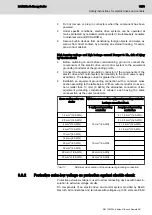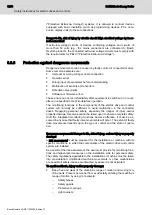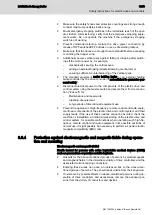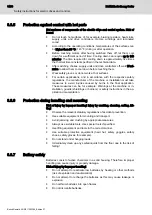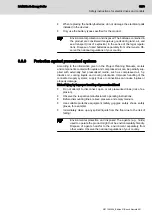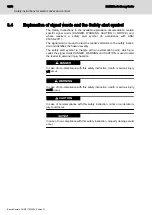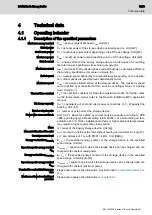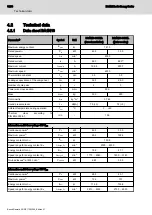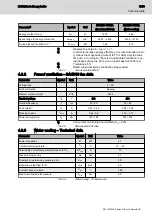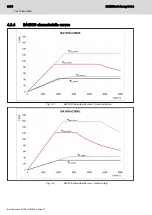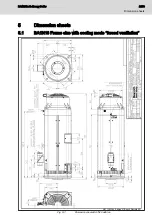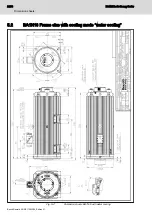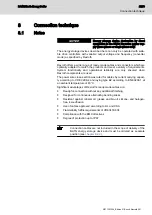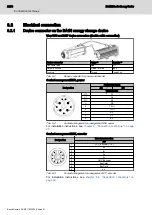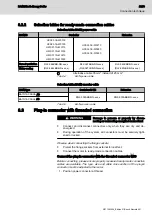
3.3.5
Protection against contact with hot parts
Hot surfaces of components of the electric drive and control system. Risk of
burns!
●
Do not touch hot surfaces of, for example, braking resistors, heat sinks,
supply units and drive controllers, motors, windings and laminated
cores!
●
According to the operating conditions, temperatures of the surfaces can
be higher than 60 °C (140 °F) during or after operation.
●
Before touching motors after having switched them off, let them cool
down for a sufficient period of time. Cooling down can require up to 140
minutes! The time required for cooling down is approximately five times
the thermal time constant specified in the technical data.
●
After switching chokes, supply units and drive controllers off, wait 15 mi‐
nutes to allow them to cool down before touching them.
●
Wear safety gloves or do not work at hot surfaces.
●
For certain applications, and in accordance with the respective safety
regulations, the manufacturer of the machine or installation must take
measures to avoid injuries caused by burns in the final application.
These measures can be, for example: Warnings at the machine or in‐
stallation, guards (shieldings or barriers) or safety instructions in the ap‐
plication documentation.
3.3.6
Protection during handling and mounting
Risk of injury by improper handling! Injury by crushing, shearing, cutting, hit‐
ting!
●
Observe the relevant statutory regulations of accident prevention.
●
Use suitable equipment for mounting and transport.
●
Avoid jamming and crushing by appropriate measures.
●
Always use suitable tools. Use special tools if specified.
●
Use lifting equipment and tools in the correct manner.
●
Use suitable protective equipment (hard hat, safety goggles, safety
shoes, safety gloves, for example).
●
Do not stand under hanging loads.
●
Immediately clean up any spilled liquids from the floor due to the risk of
falling!
3.3.7
Battery safety
Batteries consist of active chemicals in a solid housing. Therefore, improper
handling can cause injury or property damage.
Risk of injury by improper handling!
●
Do not attempt to reactivate low batteries by heating or other methods
(risk of explosion and cauterization).
●
Do not attempt to recharge the batteries as this may cause leakage or
explosion.
●
Do not throw batteries into open flames.
●
Do not dismantle batteries.
14/73
Safety instructions for electric drives and controls
BA1N Kinetic Energy Buffer
Bosch Rexroth AG R911393264_Edition 01
Summary of Contents for Rexroth BA1N
Page 1: ...BA1N Kinetic Energy Buffer Project Planning Manual R911393264 Edition 01 ...
Page 30: ...24 73 BA1N Kinetic Energy Buffer Bosch Rexroth AG R911393264_Edition 01 ...
Page 32: ...26 73 BA1N Kinetic Energy Buffer Bosch Rexroth AG R911393264_Edition 01 ...
Page 40: ...34 73 BA1N Kinetic Energy Buffer Bosch Rexroth AG R911393264_Edition 01 ...
Page 52: ...46 73 BA1N Kinetic Energy Buffer Bosch Rexroth AG R911393264_Edition 01 ...
Page 62: ...56 73 BA1N Kinetic Energy Buffer Bosch Rexroth AG R911393264_Edition 01 ...
Page 74: ...68 73 BA1N Kinetic Energy Buffer Bosch Rexroth AG R911393264_Edition 01 ...
Page 77: ...Notes BA1N Kinetic Energy Buffer 71 73 ...
Page 78: ...Notes 72 73 BA1N Kinetic Energy Buffer ...












